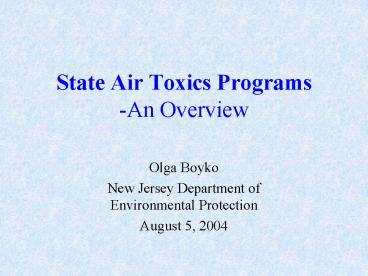State Air Toxics Programs An Overview - PowerPoint PPT Presentation
1 / 22
Title:
State Air Toxics Programs An Overview
Description:
Identify those pollutants that caused 'serious and irreversible illness, or death' ... Beryllium. Inorganic arsenic. Mercury. Radionuclides. Vinyl chloride. 5 ... – PowerPoint PPT presentation
Number of Views:27
Avg rating:3.0/5.0
Title: State Air Toxics Programs An Overview
1
State Air Toxics Programs-An Overview
- Olga Boyko
- New Jersey Department of Environmental
Protection - August 5, 2004
2
A Brief History of the Federal Air Toxics Program
- Federal attempts to regulate air toxics prior to
1990 - NESHAPS - National Emission Standards for
Hazardous Air Pollutants - Identify those pollutants that caused serious
and irreversible illness, or death - Develop standards to reduce emissions to levels
that provided an ample margin of safety
3
The NESHAPS Debate
- How valid are EPAs risk assessment methods and
assumptions? - Costs to industry?
- Benefits to human health?
- How safe is safe?
4
Federal NESHAPs ProgramIn 20 years, NESHAPs
were developed for 7 HAPs
- Asbestos
- Benzene
- Beryllium
- Inorganic arsenic
- Mercury
- Radionuclides
- Vinyl chloride
5
The Clean Air Act Amendments of 1990
- Listed 188 Hazardous Air Pollutants
- EPA must develop emission limits for specific
source categories using Maximum Achievable
Control Technology (MACT) - Then go back and look at residual risk
6
- Meanwhile, in the 1980s
- Emergence of State Programs
- Legislation, regulations, policies
7
Emergence of State Programs
- Defining air toxics
- Began with focus on exposure to carcinogens
- Expanded to include noncarcinogenic and even
short-term effects
8
What is an Air Toxic?
- CAAA 188 HAPs
- State lists
- - California TACs (54 600 188)
- - New Hampshire RTAPs (750)
- - Oklahoma toxic air contaminants (1500)
- - NJ - Anything with a toxicity value?
9
Components of State Air Toxics Programs
- Permits, controls, emission limits for stationary
sources - Compliance and enforcement
- Reporting and record-keeping
- Emissions inventories
- Modeling
- Risk assessment
- Monitoring
- Area source requirements
- Mobile source programs
- Community participation
10
Point Source Strategies
- Point/major/stationary sources were
the first, most obvious targets
for state air toxics programs - Minimalist approach
- Implement NESHAPs - about 20 states do this.
11
Permits and Registrationfor Point Sources
- Considerations
- Size, category, location
- New, modified, existing
- Risk and exposure
12
Stationary Source Control Requirements
- Emission limits
- Control equipment requirements
- - MACT (Maximum Achievable Control Technology)
- - BACT (Best Available Control Technology)
- - RACT (Reasonably-Available Control Technology)
- - LAER (Lowest Achievable Emission Rate)
- - SOTA (State-of-the-Art)
- Varying requirements that consider toxicity,
potential emissions, and potential exposure
13
Compliance Approaches
- Inspections, documentation, stack tests
- Control equipment requirements
- Emission standard or limit
- Ambient air standards
- Risk standards or targets
14
Emissions Inventories
- State regulatory requirements for
process-specific reports - TRI (Toxics Release Inventory)
- NEI (National Emission Inventory)
- Emissions statements
15
Facility Modeling
- To meet ambient standard
- To meet risk goal or standard
- Background concentrations?
- Facility-wide or process-specific?
16
Risk Assessment Approaches
- Toxicity values
- IRIS (EPAs Integrated Risk Information System)
- Californias toxicity values
- TLVs (Occupational Threshold Limit Values)
17
Risk Assessment Approaches
- Applied in different ways
- To develop lists of chemicals
- To develop lists of industries of concern
- To encourage facilities to reduce risk
- To determine if controls are stringent enough
18
Air Monitoring
- No real federal requirements
- Federal Urban Air Toxics Monitoring Program
(UATMP) - run cooperatively with states, with 56
sites in 20 states at 30 urban areas - Over 300 air toxics monitoring sites are operated
by states
19
Area/Minor Source Approaches
- Dry cleaners, electroplaters, gasoline stations
- Some are subject to MACT
- Performance standards, compliance reports
- Consumer product regulations - side benefits from
ozone regulation
20
Mobile Sources - Cars
- More side benefits from reduction of criteria
pollutants - California leads the way - Requirements for low
emissions and clean fuels - Northeast states adopting some California
initiatives (low emission vehicles) - Inspection and maintenance programs
21
Mobile Sources - Diesel
- EPAs new regulations requiring better controls
will be in effect by 2007, but old fleet will
still be on the road. - States are looking to reduce emissions now
- Cleaner fuel Truck stop electri-
- Engine retrofits fication
- Idling reduction
22
Future Directions
- Continued focus on area and mobile sources
- Community involvement
- EPA funding for community initiatives
- - NJs community project































